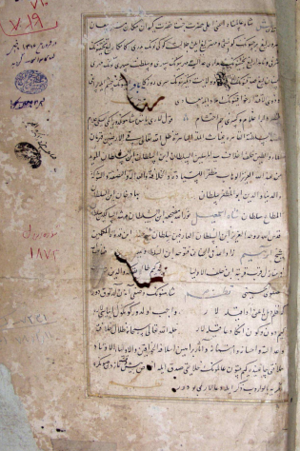تركي عجمي
| Ajem-Turkic | |
|---|---|
Ajami Turkic
| |
| ترکی عجمی Türkī-yi ʿacemī | |
| المنطقة | Iran, Eastern Anatolia, Southern Caucasus, Dagestan |
| الحقبة | 15th—18th centuries Developed into Azerbaijani |
Turkic
| |
الصيغة المبكرة | |
| Perso-Arabic alphabet | |
| أكواد اللغات | |
| ISO 639-3 | – |
Ajem-Turkic or Ajami Turkic[1] (ترکی عجمی; Türkī-yi ʿacemī,[2] حرفياً 'Persian Turkic'[3] or 'Persian Turkish'),[4] also known as Middle Azeri[3] or Middle Azerbaijanian,[4] is the Turkic vernacular spoken in Iran between the 15th and 18th centuries. The modern Azerbaijani language is descended from this language.[3]
. . . . . . . . . . . . . . . . . . . . . . . . . . . . . . . . . . . . . . . . . . . . . . . . . . . . . . . . . . . . . . . . . . . . . . . . . . . . . . . . . . . . . . . . . . . . . . . . . . . . . . . . . . . . . . . . . . . . . . . . . . . . . . . . . . . . . . . . . . . . . . . . . . . . . . . . . . . . . . . . . . . . . . . .
الاسم
The term is derived from earlier designations, such as lingua turcica agemica, or Turc Agemi, which was used in a grammar book composed by the French writer Capuchin Raphaël du Mans (died 1696) in 1684. Local texts simply called the language türkī.[3] During "the Isfahan phase of the Safavids", it was called ḳızılbaşī in contrast to rūmī (Ottoman) and çaġatā’ī (Chagatai), due to its close relation to dialects spoken by the Qizilbash.[2]
التاريخ
Ajem-Turkic is descended from Old Anatolian Turkish, and is part of the southwestern branch of Oghuz languages. The language first appears during the 15th-century in Azerbaijan, eastern Anatolia, and Iran. It went through more development under the Turkic dynasties of the Aq Qoyunlu (1378–1503) and the Qara Qoyunlu (1374–1468), and particularly in Safavid Iran (1501–1736), whose ruling dynasty stemmed from Azerbaijan. Under them, Ajem-Turkic, alongside Persian, was used at the court and in the military, and was a lingua franca from northern to southern Iran.[3] According to Swedish Turkologist Lars Johanson, Ajemi Turkic was an "Azerbaijanian koiné" that functioned as lingua franca in the Caucasus region and in southeastern Dagestan, and was widely spoken at the court and in the army.[5]
According to É. Á. Csató et al.:[4]
A specific Turkic language was attested in Safavid Persia during the 16th and 17th centuries, a language that Europeans often called Persian Turkish ("Turc Agemi", "lingua turcica agemica"), which was a favourite language at the court and in the army because of the Turkic origins of the Safavid dynasty. The original name was just turki, and so a convenient name might be Turki-yi Acemi. This variety of Persian Turkish must have been also spoken in the Caucasian and Transcaucasian regions, which during the 16th century belonged to both the Ottomans and the Safavids, and were not fully integrated into the Safavid empire until 1606. Though that language might generally be identified as Middle Azerbaijanian, it is not yet possible to define exactly the limits of this language, both in linguistic and territorial respects. It was certainly not homogenous—maybe it was an Azerbaijanian-Ottoman mixed language, as Beltadze (1967:161) states for a translation of the gospels in Georgian script from the 18th century.
الأدب
Since its appearance, Ajem-Turkic was heavily impacted by الفارسية, especially in its syntax. The Persian design of merging clauses which Ajem-Turkic had inherited from Old Anatolian Turkish was strengthened due to its continuous contact with Persian.[3]
Sources for the study of Ajemi-Turkic include the prose texts of Nishati (fl. 1530–after 1557), the Tarih-i Hatai (Tārīkh-i Khatāʾī, 1494/95); Şühedaname (Şühedānāme, 1539)؛ و تذكرة الشيخ صافي (Tedhkire-i Şeykh Ṣafī, 1542/43).[3]
المراجع
- ^ H. Boeschoten (2009). "Alexander Stories in Ajami Turkic". Turcologica. Wiesbaden. 75.
- ^ أ ب In Honor of the Turkologist!: Essays Celebrating the 70th Birthday of Ekrem Čaušević. Zagreb: Faculty of Philosophy in Zagreb. 2022. pp. 103–105. ISBN 978-953-175-937-3.
- ^ أ ب ت ث ج ح خ Stein 2014.
- ^ أ ب ت É. Á. Csató, B. Isaksson, C Jahani. Linguistic Convergence and Areal Diffusion: Case Studies from Iranian, Semitic and Turkic, Routledge, 2004, p. 228, ISBN 0-415-30804-6.
- ^ Lars Johanson; Éva Á. Castó (1998). "14". The Turkic Languages. Routledge. pp. 248–261.
المصادر
- Stein, Heidi (2014). "Ajem-Turkic". In Fleet, Kate; Krämer, Gudrun; Matringe, Denis; Nawas, John; Rowson, Everett (eds.). Encyclopaedia of Islam, THREE. Brill Online. ISSN 1873-9830.
للاستزادة
- Claudia Römer (2022). "Elements of Türkī-yi ʿacemī in an eyewitness report on the Ottoman siege of Baghdad (1034-35/1625-26) preserved in Iskandar Munşī's ʿĀlam-ārā-yi ʿAbbāsī". Institut für Orientalistik der Universität Wien.
- Johanson, Lars (2020). "Restricted Access Isfahan – Moscow – Uppsala. On Some Middle Azeri Manuscripts and the Stations Along Their Journey to Uppsala". In Csató, Éva Á.; Gren-Eklund, Gunilla; Johanson, Lars; Karakoç, Birsel (eds.). Turcologica Upsaliensia: An Illustrated Collection of Essays. Brill. pp. 167–179. ISBN 978-9004435704.
- Stein, Heidi (2005). "Ajem-Türkisch: Annäherung an eine historische Sprachform zwischen Osmanisch, Persisch und Osttürkisch [Ajem-Turkish: Convergence of a historical variety between Ottoman, Persian, and East Turkic]". Orientalia Suecana (in الألمانية). 54: 179–200.
- Short description matches Wikidata
- Language articles without language codes
- Language articles with unreferenced extinction date
- Language articles missing Glottolog code
- CS1 الألمانية-language sources (de)
- Azerbaijani language
- Extinct languages of Asia
- Languages attested from the 15th century
- Oghuz languages
- Lingua francas
- Extinct languages of Europe
